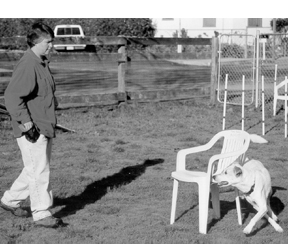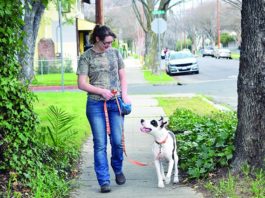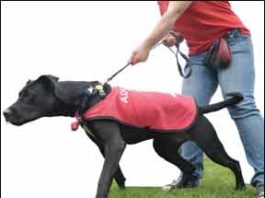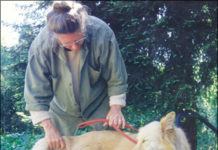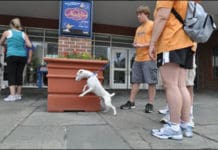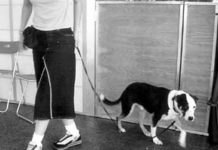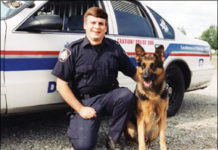Best Types of Crates for Dog Training
Whole Dog Journal has written a lot in the past about the usefulness of having a comfortable crate your dog calls home. Crates are a convenient way to keep your dog out of harm's way, out of your way, and away from guests when necessary. A crate is regarded as the safest way to transport dogs in the car, and if you ever fly with your dog, you're going to need a crate for that too.
Counter-Conditioning and Desensitization (CC&D)
Counter conditioning and desensitization (CC&D) involves changing your pup's association with a scary stimulus from negative to positive. The easiest way to give most pups a positive association is with very high-value, really yummy treats. I like to use chicken canned, baked or boiled.
Has Your Senior Dog Started to Lose His Hearing?
If we're fortunate enough to have them live to old age, at some point, most of our canine companions begin to lose their hearing and may eventually be, for all intents and purposes, deaf. It's painful to watch a beloved dog become less and less responsive to his environment because he's unaware of what's going on around him, and even more so when it limits your ability to communicate with him. The thought of a hearing-impaired dog wandering off and not being able to hear your calls is frightening. Here are five things you can do if your dog's hearing isn't what it used to be.
The Tellington TTouch For Dogs
of Berkeley
Training a Dog to Make Choices
One would expect that the rise of force-free training methods and the increased awareness of and respect for dogs as sentient creatures would make life easier for them. We should expect to see a corresponding rise in the number of calm, stable, well-adjusted dogs who are happily integrated into lifelong loving homes. But many training and behavior professionals note with alarm the large number of dogs in today's world who seem to have significant issues with stress and anxiety, with high levels of arousal and low impulse control.
How to Train Your Dog to Calmly Walk on Leash
Passing by all manner of things in the real world - and being passed by them - is an important canine good manners skill. Unfortunately, it seems to be one that is absent in many dogs’ behavior repertoires. Some training classes don’t address this behavior challenge at all. Others do, but owners don’t always take time to generalize the behavior outside the training center. Their dogs, in the real world, still bounce over to greet any and all comers on the street, or on the opposite end of the continuum, shy away from people and things that frighten them. My “Downtown Hound” class graduated in early September with a celebration at Nutter’s Ice Cream in nearby Sharpsburg. It was a 90 degree-plus day with high humidity, and the ice cream parlor was a popular spot in this small Maryland community. I watched with pride as the four dogs lay quietly at their humans’ feet, happily downing the occasional offered dog treat while their owners licked ice cream cones. More importantly, they rested quietly as people walked by with strollers and dogs, kids on skateboards flew past noisily, and motorcycles, trucks, and cars rumbled by a few feet away on busy Main Street.
Classical Conditioning – How Your Dog Learns by Association
we
simply pour on the treats
simply pour on the treats
Tethering Your Dog for Training
For many years, I have been a vigorous and vocal opponent of keeping dogs tied or chained as a primary means of confinement. The hazards of tying a dog are well-documented, and include increased aggression, vulerability to human and non-human intruders, and the risk of hanging or choking. It may come as a surprise, therefore, to know that I regard the tether as an invaluable piece of training equipment. The difference and it's a big one is in the application.
Training the Hearing Impaired Dog
hearing and deaf. Using a treat in your hand
Ways to Combat Your Dog’s Indoor Urine-Marking
I can still remember the day, more than a decade ago, when I first realized with horror that our Scottish Terrier, Dubhy (pronounced Duffy")
How to Train Your Dog for Off-Leash Walks
Taking a dog for a walk or hike off-leash must be done appropriately and legally in order to prevent any number of risks to the dog, other dogs, or humans who may encounter the off-leash dog, as well as livestock or wildlife in the area. Off-leash dogs may run off and get lost, run onto roads and cause serious accidents, cause hikers to fall and bicyclists to crash, and chase or even kill other animals.
Training Police Dogs and Military Dogs Using Positive Methods
both for law enforcement and civilian trainers.üStaff Sgt. William Riney uses a toy and a game of tug to reward his military dog for detecting narcotics around vehicles on the grounds of Lackland Air Force Base


